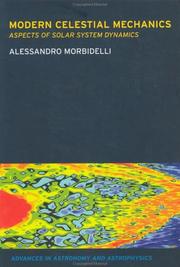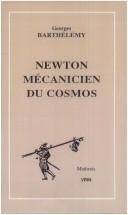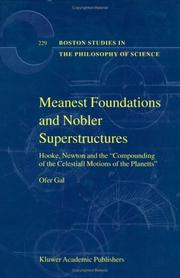| Listing 1 - 4 of 4 |
Sort by
|

ISBN: 0415279399 0415279380 9780415279383 Year: 2002 Volume: 5 Publisher: London ; New York : Taylor & Francis,
Abstract | Keywords | Export | Availability | Bookmark
 Loading...
Loading...Choose an application
- Reference Manager
- EndNote
- RefWorks (Direct export to RefWorks)
Celestial mechanics --- Mécanique céleste --- Mécanique céleste

ISSN: 11474920 ISBN: 2711611094 9782711611096 Year: 2002 Publisher: Paris : Librairie philosophique J. Vrin,
Abstract | Keywords | Export | Availability | Bookmark
 Loading...
Loading...Choose an application
- Reference Manager
- EndNote
- RefWorks (Direct export to RefWorks)
Philosophy of nature --- Newton, Isaac, --- Newton, Isaac, - 1642-1727 - Principia --- Gravitation. --- Mécanique analytique --- Mécanique céleste --- Histoire. --- Critique et interprétation. --- Newton, Isaac, 1642-1727 - Principia
Book
ISBN: 0715630709 9780715630709 9781472557377 9781472557919 9781472557957 9781472557438 9781472557414 9781472558121 9781472557841 9781472557858 1472557859 1472557840 9780715638446 9780715638439 0715638432 Year: 2002 Publisher: London Duckworth
Abstract | Keywords | Export | Availability | Bookmark
 Loading...
Loading...Choose an application
- Reference Manager
- EndNote
- RefWorks (Direct export to RefWorks)
Four elements (Philosophy) --- Four elements (Philosophy). --- Cosmology, Ancient. --- Astronomy, Ancient --- Aristotle. --- Cosmology, Ancient --- Celestial mechanics --- Astronomy, Greek --- Cosmology --- Motion --- Science, Ancient --- Logic --- Aristotle --- Astronomy --- Astronomy. --- Motion. --- Science, Ancient. --- Aristoteles, --- Aristoteles. --- De caelo (Aristotle). --- Cosmologie antique --- Astronomie antique --- Mécanique céleste --- Aristote, --- Philosophy of nature --- Cosmologie antique. --- Astronomie antique. --- Mécanique céleste. --- Astronomy, Ancient. --- Cosmology. --- Geschichte 550. --- Aristote

ISBN: 1402007329 9048160677 9401722234 Year: 2002 Volume: 229 Publisher: Dordrecht Boston London Kluwer Academic Publishers
Abstract | Keywords | Export | Availability | Bookmark
 Loading...
Loading...Choose an application
- Reference Manager
- EndNote
- RefWorks (Direct export to RefWorks)
This book is a historical-epistemological study of one of the most consequential breakthroughs in the history of celestial mechanics: Robert Hooke's (1635-1703) proposal to "compoun[d] the celestial motions of the planets of a direct motion by the tangent & an attractive motion towards a centrat body" (Newton, The Correspondence li, 297. Henceforth: Correspondence). This is the challenge Hooke presented to Isaac Newton (1642-1727) in a short but intense correspondence in the winter of 1679-80, which set Newton on course for his 1687 Principia, transforming the very concept of "the planetary heavens" in the process (Herivel, 301: De Motu, Version III). 1 It is difficult to overstate the novelty of Hooke 's Programme • The celestial motions, it suggested, those proverbial symbols of stability and immutability, werein fact a process of continuous change: a deflection of the planets from original rectilinear paths by "a centraU attractive power" (Correspondence, li, 313). There was nothing necessary or essential in the shape of planetary orbits. Already known to be "not circular nor concentricall" (ibid. ), Hooke claimed that these apparently closed "curve Line[ s ]" should be understood and calculated as mere effects of rectilinear motions and rectilinear attraction. And as Newton was quick to realize, this also implied that "the planets neither move exactly in ellipse nor revolve twice in the same orbit, so that there are as many orbits to a planet as it has revolutions" (Herivel, 301: De Motu, Version III).
Celestial mechanics --- Gravitational astronomy --- Hemelmechanica --- Mechanica [Hemel] --- Mechanics [Celestial ] --- Mécanique céleste --- Celestial mechanics. --- Hooke, Robert, --- Newton, Isaac, --- Newton, Isaac --- Hooke, Robert --- Mechanics, Celestial --- Newton, Izaak, --- Niu-tun, --- Nʹi︠u︡ton, Isaak, --- Niutun, Yisake, --- Niyu̇ton, Isak, --- Nyuṭon, Ayzaḳ, --- Nyuṭon, Ayziḳ, --- ניוטאן, אייזאק, --- ניוטון, אייזק --- ניוטון, אייזיק --- 牛頓, --- 牛頓, 伊萨克, --- Guk, Robert, --- Astrophysics --- Mechanics --- History. --- Philosophy and science. --- Physics. --- Observations, Astronomical. --- Astronomy—Observations. --- Philosophy. --- History, general. --- Philosophy of Science. --- History and Philosophical Foundations of Physics. --- Astronomy, Observations and Techniques. --- Philosophy of Technology. --- Mental philosophy --- Humanities --- Astronomical observations --- Observations, Astronomical --- Natural philosophy --- Philosophy, Natural --- Physical sciences --- Dynamics --- Science and philosophy --- Science --- Annals --- Auxiliary sciences of history
| Listing 1 - 4 of 4 |
Sort by
|

 Search
Search Feedback
Feedback About UniCat
About UniCat  Help
Help News
News